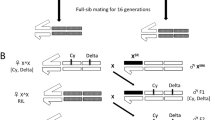Abstract
Heterologous segregation of the Y chromosome and secondary non-disjunction of the X chromosomes in female meiosis of Drosophila melanogaster was investigated in ten different crosses where different constellations of translocation/inversion or translocation/translocation systems of the large autosomes were present in the female parent. It appeared that the Y chromosome always segregates from the shortest of the possible heterologous pairing partners. This may be due to size-dependent mechanism of so-called ‘distributive disjunction’ or to the possibility that the shorter the chromosome element is, the more easily it moves in the nucleus of the oocyte. Secondary non-disjunction of the X chromosomes appeared to be lower the more possible autosomal pairing partners the Y chromosome had, suggesting that the autosomes effectively compete with the X chromosomes for pairing with the Y chromosome. An alternative explanation is that, due to interchromosomal effect on recombination, crossing over in the X chromosomes was different in different experiments.
Similar content being viewed by others
Reference
CarpenterA. T. C., 1991. Distributive segregation: Motors in the polar wind? Cell 64: 885–890.
DouglasL. T., 1968. Meiosis III. The elastica and Markov processes as models for non-random segregation from associated nonhomologues in Drosophila. Genetica 39: 289–328.
GrellR. F., 1957. Nonrandom assortment of non-homologous chromosomes. (Abstract). Genetics 65: 374.
GrellR. F., 1959. Nonrandom assortment of non-homologous chromosomes in Drosophila melanogaster. Genetics 44: 421–435.
GrellR. F., 1962. A new hypothesis on the nature and sequence of meiotic events in female of Drosophila melanogaster. Proc. Natl. Acad. Sci. USA. 48: 165–172.
GrellR. F., 1964a. Chromosome size at distributive pairing in Drosophila melanogaster females. Genetics 50: 151–166.
GrellR. F., 1964b. Distributive pairing: the size-dependent mechanism for regular segregation of the fourth chromosomes in Drosophila melanogaster. Proc. Natl. Acad. Sci. USA. 52: 226–232.
GrellR. F., 1976. Distributive pairing. In: M.Ashburner and E.Novitski (Eds), The Genetics and Biology of Drosophila, Vol. 1a. Academic Press, London, pp. 436–486.
GrellR. F. & GrellE.H., 1960. The behavior of non-homologous chromosomal elements involved in nonrandom assortment in Drosophila melanogaster. Proc. Natl. Acad. Sci. USA. 46: 51–57.
GuacciV. & KabackD. B., 1991. Distributive disjunction of authentic chromosomes in Saccharomyces cerevisiae. Genetics 127: 475–488.
HolmD. G. & ChovnickA., 1975. Compound autosomes in Drosophila melanogaster: The meiotic behavior of compound thirds. Genetics 81: 293–311.
Lindsley, D. & Zimm, G., 1987. The Genome of Drosophila melanogaster: Part 3: rearrangements. Dros. Inf. Serv. 65.
NokkalaS. & PuroJ., 1976. Cytological evidence for a chromocenter in Drosophila melanogaster oocytes. Hereditas 83: 265–268.
NovitskiE., 1964. An alternative to the distributive pairing hypothesis in Drosophila. Genetics 50: 1449–1451.
NovitskiE. & PuroJ., 1978. A critique of theories of meiosis in the female of Drosophila melanogaster. Hereditas 89: 51–67.
OksalaT., 1957a. The mechanism of secondary nondisjunction of X chromosomes and autosomes. Dros. Inf. Serv. 31: 147–148.
OksalaT., 1957b. Pairing pattern of the chromosomes in female meiosis in Drosophila and the ‘interchromosomal effect on crossing over’. Dros. Inf. Serv. 31: 149.
OksalaT., 1958. Chromosome pairing, crossing over, and segregation in meiosis in Drosophila melanogaster females. Cold Spring Harbor Symp. Quant. Biol. 23: 197–210.
PuroJ. & NokkalaS., 1977. Meiotic segregation of chromosomes in Drosophila melanogaster oocytes. A cytological approach. Chromosoma 63: 273–286.
PuroJ., 1991. Differential mechanisms governing segregation of a univalent in oocytes and spermatocytes of Drosophila melanogaster. Chromosoma 100: 305–314.
SturtevantA.H. & BeadleG. W., 1962. In Introduction to Genetics. 391 pp. Dover, New York.
ZhangP., KnowlesB. A., GoldsteinL. S. B. & HawleyR. S., 1990. A kinesin-like protein required for distributive chromosome segregation in Drosophila. Cell 62: 1053–1062.
ZhangP. & HawleyR. S., 1990. The genetic analysis of distributive segregation in Drosophila melanogaster. II. Further genetic analysis of the nod locus. Genetics 125: 115–127.
Author information
Authors and Affiliations
Rights and permissions
About this article
Cite this article
Portin, P. Partner choice in heterologous chromosome segregation of the Y chromosome in competitive situations in the oocyte of Drosophila melanogaster . Genetica 85, 139–145 (1992). https://doi.org/10.1007/BF00120320
Received:
Accepted:
Issue Date:
DOI: https://doi.org/10.1007/BF00120320




